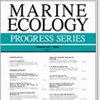Effects of light and water column nutrient availability on eelgrass Zostera marina productivity in Eeyou Istchee, eastern James Bay, Quebec
IF 2.1
3区 环境科学与生态学
Q2 ECOLOGY
引用次数: 0
Abstract
ABSTRACT: Eelgrass Zostera marina meadows provide valuable ecosystem services to coastal communities. These shallow-water ecosystems in Eeyou Istchee (eastern James Bay, Quebec, Canada) support Cree ways of life by providing waterfowl foraging habitat, fish nurseries, and natural storm buffers. In 2019-2021, Eeyou Istchee eelgrass extent and shoot size remained well below historical baseline levels following a major decline in the late 1990s. We experimentally tested the potential roles of present-day nutrient and light conditions in limiting eelgrass productivity during the growing season. We tested the hypothesis that eelgrass growth is limited by water column nutrients using in situ nutrient additions in 2 eelgrass meadows. Eelgrass growth rate did not respond to nutrient addition at either site. We then assessed the ability of eelgrass to grow in low light conditions by producing ex situ production-irradiance curves. Eelgrass at both sites showed no evidence of low light acclimatization with saturating irradiances of 224 and 260 µmol photons m-2 s-1 and compensation points of 31 and 61 µmol photons m-2 s-1. We observed eelgrass growth rates of about 3.8% areal growth per day during the peak growth period, which are high when compared to other rates globally. Together, our results suggest that Eeyou Istchee eelgrass is growing under sufficient water column nutrient levels, but suboptimal growing season water column light conditions. Because Eeyou Istchee eelgrass meadows must endure long periods of seasonal ice-cover, light limitation during the short growth season may have longer-lasting impacts on these meadows than in more temperate ones.魁北克詹姆斯湾东部 Eeyou Istchee 的光照和水体营养供应对鳗草 Zostera marina 生产力的影响
摘要:鳗草 Zostera marina 草甸为沿海社区提供了宝贵的生态系统服务。Eeyou Istchee(加拿大魁北克省詹姆斯湾东部)的这些浅水生态系统通过提供水禽觅食栖息地、鱼类苗圃和天然风暴缓冲区,支持克里人的生活方式。20 世纪 90 年代末,Eeyou Istchee 的鳗草面积和嫩枝大小大幅减少,2019-2021 年,鳗草面积和嫩枝大小仍远低于历史基线水平。我们通过实验测试了目前的营养和光照条件在生长季节限制黄鳝草生产力的潜在作用。我们在 2 个黄颡草草甸原地添加营养物,检验了黄颡草生长受水体营养物限制的假设。在这两个地点,黄鳝草的生长速度均未对营养物质的添加作出反应。然后,我们通过制作原地产量-辐照度曲线,评估了黄鳝草在弱光条件下的生长能力。两个地点的鳗草都没有表现出适应弱光的迹象,饱和辐照度分别为 224 和 260 µmol photons m-2 s-1,补偿点分别为 31 和 61 µmol photons m-2 s-1。我们观察到,在生长高峰期,鳗草的生长率约为每天 3.8% 的面积增长,与全球其他生长率相比,这一生长率较高。我们的研究结果表明,Eeyou Istchee 的黄鳝草是在水体营养水平充足但生长季节水体光照条件不理想的情况下生长的。由于埃厄伊什奇的鳗草草甸必须经受长时间的季节性冰盖,与温带草甸相比,短生长期的光照限制可能会对这些草甸造成更持久的影响。
本文章由计算机程序翻译,如有差异,请以英文原文为准。
求助全文
约1分钟内获得全文
求助全文
来源期刊

Marine Ecology Progress Series
环境科学-海洋学
CiteScore
5.30
自引率
8.00%
发文量
238
审稿时长
3 months
期刊介绍:
The leading journal in its field, MEPS covers all aspects of marine ecology, fundamental and applied. Topics covered include microbiology, botany, zoology, ecosystem research, biological oceanography, ecological aspects of fisheries and aquaculture, pollution, environmental protection, conservation, and resource management.
 求助内容:
求助内容: 应助结果提醒方式:
应助结果提醒方式:


